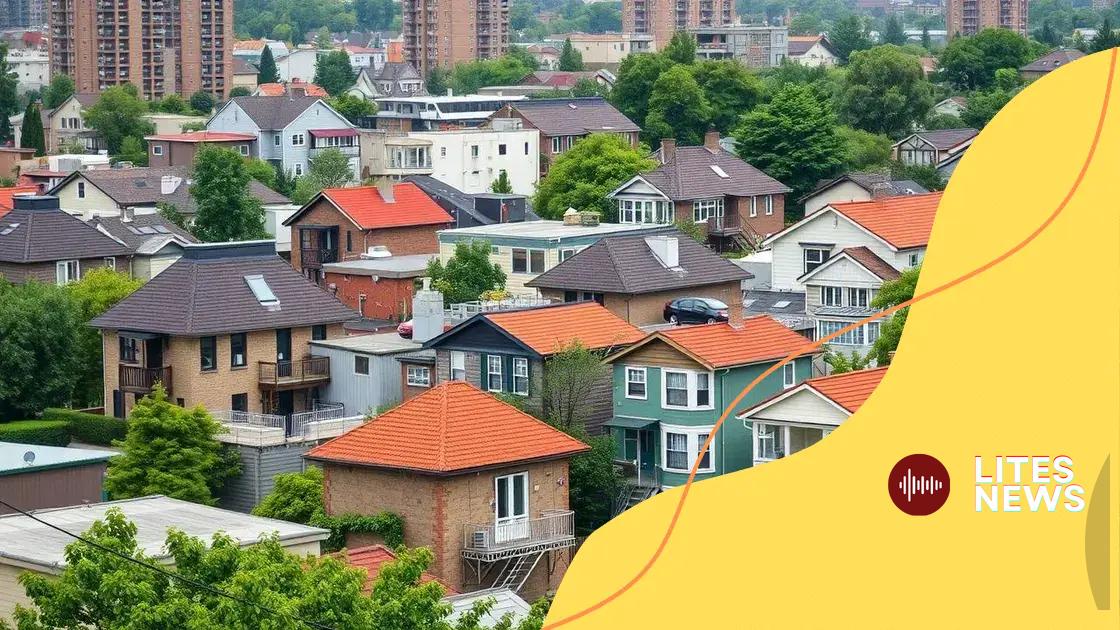Affordable housing initiatives transforming urban living

Affordable housing initiatives are programs designed to provide low-income families with safe, stable, and affordable housing options, fostering community well-being and economic growth.
Affordable housing initiatives are gaining traction in cities worldwide. But what makes them so vital for urban communities? As housing costs soar, these programs aim to provide more accessible living options, inviting us to consider their impact.
Understanding affordable housing initiatives
Understanding affordable housing initiatives is essential for grasping how communities can create positive change. These programs aim to provide safe and reliable homes at prices families can afford. Let’s explore the key aspects of these initiatives.
What are affordable housing initiatives?
Affordable housing initiatives refer to various strategies and programs designed to make housing accessible to lower-income individuals and families. The goal is to reduce homelessness and ensure everyone has a place to live. Different regions may implement different plans, catering to their unique community needs.
Key Components
- Subsidized housing programs
- Inclusionary zoning laws
- Funding for construction and renovation
- Community land trusts
Each of these components plays a role in increasing the availability of affordable housing. For instance, subsidized housing reduces rent costs, allowing families to spend less of their income on housing.
Communities also benefit when affordable housing is prioritized. When residents have stable living conditions, they tend to participate more in local activities and support neighborhood development.
Moreover, these initiatives often promote mixed-income developments, improving the overall vibrancy of neighborhoods. By integrating different income groups, residents can share resources and cultural experiences, leading to stronger community ties.
Challenges in Implementing Initiatives
Despite their benefits, affordable housing initiatives face several challenges. These include limited funding, political obstacles, and neighborhood opposition. Many times, local government support is necessary to push through affordable housing projects.
- Insufficient government funding
- Public resistance to new developments
- Zoning restrictions
- Market pressures driving up costs
Understanding these challenges is key to advocating for better solutions. Solutions that include community input can often mitigate resistance and lead to successful project completion.
In conclusion, affordable housing initiatives represent crucial efforts to improve community well-being. By making housing accessible, we create a foundation for healthier, happier neighborhoods where everyone can thrive.
Benefits of affordable housing for communities
The benefits of affordable housing for communities are significant and wide-ranging. Affordable housing not only helps families but also strengthens neighborhoods. It leads to better economic conditions, improved health, and greater social connections.
Economic Impact
When families have access to affordable housing, they can spend less on rent. This allows them to allocate their funds toward other essential needs, such as education and healthcare. Increased disposable income can stimulate local businesses and create jobs.
Health and Wellbeing
Housing stability contributes to better mental and physical health. Families in stable environments face fewer stressors, which can lead to improved overall wellbeing. A safe and secure home provides the necessary foundation for children to thrive.
- Reduced stress and anxiety
- Better access to medical services
- Improved academic performance for children
- Lower rates of illness
Communities flourish when residents can focus on their health and education instead of worrying about housing security. This focus fosters a sense of belonging and community pride.
Moreover, affordable housing initiatives can lead to diverse communities. When different income levels reside in the same area, it promotes understanding and collaboration among residents. This diversity enriches local culture and enhances social networks.
Social Benefits
Strong communities often emerge from a foundation of stable, affordable housing. Residents tend to engage more in community activities, such as local events and volunteering. Increased participation strengthens bonds and leads to a supportive environment.
- Higher community engagement
- Enhanced safety through neighborhood watch programs
- Shared resources and services
- Improved quality of life
In summary, the benefits of affordable housing for communities extend beyond just providing shelter. It creates opportunities for economic growth, enhances health outcomes, and fosters social connections. Investing in affordable housing initiatives is essential for building vibrant and resilient communities.
Challenges faced by affordable housing projects

Challenges faced by affordable housing projects can significantly hinder their success. Understanding these obstacles is crucial for anyone involved in creating solutions that work for communities.
Funding Limitations
One of the primary challenges is securing adequate funding. Many affordable housing initiatives rely on government grants, donations, or loans, which can be scarce. When funds are insufficient, projects may be delayed or scaled back, affecting their effectiveness.
Regulatory Hurdles
Another significant challenge is navigating the complex web of regulations and zoning laws. Local governments often have strict zoning laws that can restrict the type and amount of housing that can be built. As a result, developers face delays and increased costs as they work to meet all necessary requirements.
- Lengthy approval processes
- Strict building codes
- Neighborhood opposition to new developments
Many communities resist new developments, fearing changes to their neighborhood’s character. This resistance can slow down projects and create conflicts between developers and residents.
Market Pressures
The housing market itself poses challenges as well. Rising costs for land and materials can make affordable housing projects less feasible. As demand for housing increases, prices often outpace what developers can offer.
Additionally, competing interests can make it tough to prioritize affordable housing. Developers may focus on higher profits from luxury housing, leaving affordable units underfunded.
Community Engagement
Engaging the community is vital, but also a challenge. Developers need to work closely with residents to gain support. Lack of communication can lead to misunderstandings and resentment. Ensuring residents feel included can foster cooperation, which is essential for successful projects.
- Building trust with community members
- Addressing concerns and feedback
- Involving local organizations in planning
Overall, thoroughly understanding these challenges is the first step in creating effective strategies for overcoming them. Solutions that address funding, regulation, market dynamics, and community needs will lead to successful affordable housing initiatives.
Examples of successful affordable housing programs
Examples of successful affordable housing programs can inspire communities to take action. These programs demonstrate how collaboration and creativity can make a difference.
1. Habitat for Humanity
This nonprofit organization exemplifies how community involvement can create affordable homes. Habitat for Humanity builds houses using volunteer labor and donations. Families contribute by helping to build their homes, fostering a sense of ownership and pride.
- Affordable housing for low-income families
- Community volunteer engagement
- Support through education and advocacy
This model has been replicated in many cities worldwide, proving effective in addressing housing needs.
2. Inclusionary Zoning in New York City
New York City has implemented inclusionary zoning laws that require developers to include affordable units in new residential projects. This approach has led to thousands of affordable housing units being built in desirable neighborhoods. It helps integrate various income levels and promotes diversity.
3. The Low-Income Housing Tax Credit (LIHTC)
The LIHTC program is a federal initiative that provides tax credits to developers who build or rehabilitate affordable rental housing. This program has created millions of units across the country, making a significant impact on low-income families.
- Encourages private investment
- Promotes affordable rental projects
- Boosts economic development
Through this program, developers receive financial incentives, helping to bridge the funding gap often faced in affordable housing projects.
4. Community Land Trusts
Community land trusts (CLTs) are another successful model that ensures long-term affordability. These nonprofit organizations buy and hold land, while allowing homeowners to purchase only the house on it. This keeps housing costs stable and prevents gentrification.
- Ensures permanent affordability
- Empowers local communities
- Provides a sustainable model for homeownership
CLTs foster community engagement and provide a pathway to ownership for many low-income families.
These examples highlight the diverse approaches to tackling the affordable housing crisis. By understanding and implementing successful initiatives, communities can create lasting positive change.
Future of affordable housing initiatives
The future of affordable housing initiatives is critical as cities continue to grow and face housing shortages. Innovative solutions are emerging to create sustainable housing options that meet rising demands.
Increased Collaboration
Future initiatives will likely involve greater collaboration among governments, nonprofits, and the private sector. By pooling resources and expertise, these groups can develop comprehensive strategies to address housing needs effectively.
- Public-private partnerships to finance projects
- Shared resources among organizations
- Community involvement in decision-making
Such collaborations can lead to more efficient use of funds and better outcomes for communities seeking affordable options.
Technological Innovations
Technology will play a vital role in shaping the future of affordable housing. Advancements in construction methods, such as modular and prefabricated housing, can significantly reduce costs and construction time. These innovations provide faster solutions for communities in need.
Smart home technology will also enhance living standards. Integrating energy-efficient appliances and systems can help families save on utility bills, making housing more affordable over time. This approach promotes sustainability and environmental responsibility.
Focus on Sustainability
As awareness of climate change grows, sustainable building practices will become increasingly vital. Future affordable housing initiatives may prioritize eco-friendly materials and designs. This focus not only benefits the environment but also creates healthier living conditions for residents.
- Use of renewable energy sources
- Efficient water management systems
- Green spaces and community gardens
By incorporating sustainability into affordable housing design, communities will foster a sense of collective responsibility and stewardship.
Policy Changes
Future policies will also likely shift to support affordable housing initiatives. Governments may introduce incentives for developers to create affordable units. This could include tax breaks or expedited permitting processes.
Moreover, there will be a need for policies that protect tenants and promote housing stability. Implementing regulations against discrimination and ensuring fair rental practices will be crucial for fostering inclusive communities.
In essence, the future of affordable housing initiatives depends on innovation, collaboration, and a commitment to sustainability. By addressing these factors, communities can create durable housing solutions for generations to come.
In conclusion, the future of affordable housing initiatives looks promising. By fostering collaboration among communities, embracing technology, and prioritizing sustainability, we can create homes that are not only affordable but also supportive of healthy living. As we move forward, it’s essential to advocate for policies that protect tenants and promote inclusive practices. Together, we can build vibrant communities where everyone has a place to thrive.
\n\n





